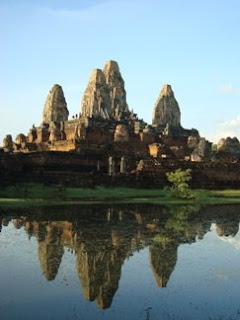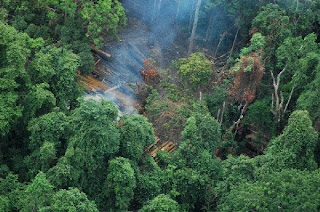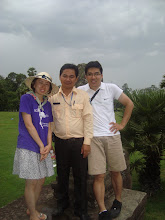
Cambodia - Kingdom of Wonder
My Services:
I am a licensed Angkor tour guide who is fluent in English. I have been leading tourists through the Angkor temple sights and explaining to them the rich history of the ancient Khmer Empire for the past seven years.
Becoming a licensed tour guide is a long and expensive process. Only certified guides are allowed to accompany tourists into the temples. If you wish to enjoy a thorough and informed explanation of the history, art, and architecture of ancient Angkor as you explore the Temples step-by-step, you must be accompanied by a licensed guide. Unlicensed guides are not allowed into the premises with tour groups.
For only US $20 a day I will be your reliable and informed guide to the mysteries of my ancestors' culture and empire.

Hotel and Guest House .
Siem Reap is full of hotels and guesthouses; there is an option for all tastes and budgets. We have lavish, five-star hotels that provide excellent comfort and service as well as cozy, family-run guesthouses where you can stay for just a few dollars a night.
Having worked and lived in Siem Reap for many years, I have built a network of friends and colleagues and can secure for you rooms at prices far below the usual rate. Looking for a hotel with a spa and room service? I know just the place. Prefer simpler comforts and the chance to meet a local Khmer family while they prepare your breakfast? I know the perfect place to find that as well. Let me know you preferences when you email and I will take care of everything.
Transportation:

There are many modes of transportation for your exploration of Angkor. Whether you prefer the comfort of an air-conditioned car, the excitement of a motorbike, or the pleasure of group ride in a motorized tuk-tuk tax, I can find the safest and most comfortable option for you.
Cars start at an additional US $20 for a full day in the Angkor temple complex, all petrol included, for a four seater. Vans with eight to fifteen seats cost US $30. Half-day rentals are available as well. I operate all of the vehicles myself.
Pick-up and deposit to the Siem Reap Airport, Siem Reap bus station, and the Tonle Sap boat landing is free.
Exploring by tuk-tuk is one of the best and most popular ways of exploring the temples.

Each tuk-tuk can carry four passengers and your drive into the jungle will be in the open air, the breeze and the smells of Khmer cooking in roadside stands wafting around you. If the day includes rain, you are covered under the tuk-tuk's canopy,and if the rain becomes a downpour, protective flaps are easily unfurled to create a private carriage for you.
Tuk-tuks cost US $13 per day and covers the entire Angkor complex.

Tourists who want to experience the Khmer motobike, the main mode of transportation in Cambodia's cities,
Can hop on back and listen to me point out the secrets of Ancient Angkor as we whizz down the road. Cambodian motos are very comfortable and the ideal mode of transportation for the solo traveler. Motos cost US $10 per person, per moto.
Helmets are provided free of charge.
I can also arrange transportation to various border crossings, including the Poipet crossing into Thailand and multiple crossings into Vietnam, as well as intra-Cambodian trips to Phnom Penh, Siahnoukville, Battambang, and other popular and less-visited locations

Countryside Tours
I grew up in Siem Reap Province in a village known as Palmtree Village. The vast majority of Cambodians live in small villages just like this one. Exploring the modern opportunities in Siem Reap and the ancient spectacles of the temples are fantastic opportunities, but to fully explore Khmer culture and the struggles that Cambodia continues to face, a trip to the countryside is essential. Cambodia is the poorest country in Southeast Asia and Siem Reap province remains the second poorest province in the country.
There are many villages that I work with that love to receive foreigners for a visit. Travel with me to see water buffalo, stilt houses, and traditional rice cultivation in vibrantly green paddies. The people of the countryside are generous and friendly and life is slow. Traveling to one of these villages brings further interest and income to them. A visit to them is a way for generous individuals to help redress the economic imballance in Cambodian society.
Adventure Temple Tours

Banteay Srei Temple
Half Day Tour.
Banteay Srei temple was built in 967 AD. It is the only temple in the
kingdom built of pink and yellow sandstone, higher quality and harder stone that was later abandoned for the grey and green sandstone used to built later temples like Angkor Wat. This superior stone has ensured that the carvings of Banteay Srei have remained in such fantastic condition, offering a rare opportunity to visitors who explore beyond the immediate temple complex.
Kbal Spean
This place, holy to the ancient Khmer, still shows the sacred lingas and other reliefs carved into the rock riverbed so many centuries ago.


Sunset Tour On Phnom Bakhen
Two hour tour: 4:30-6:30
This temple has 109 tours and offers a spectacular view of the sun setting into the jungle behind Angkor Wat. Elephant rides are available to make the climb.
Elephant Ticket : US$ 20 per person will go up the mountain and US$ 15 for getting down.

Kulen Mountain
Full Day Tour, USD$20 per person
Kulen Mountian is around 60km north of Angkor Wat and one of the holiest places in Cambodia. The waters of the Siem Reap river, so important for the Angkor Empire, flowed from this mountain, and visitors can still see the fertility symbols carved into the riverbed centureis ago to ensure continued prosperity. Holy men study here and ascetic hermits live in ancient pagodas. It was at Kulen that the Devaraja cult was born, turning the human rulers of the Khmer into gods. Pilgrimages are still made to the mountain, and visitors can swim in the clean, cool water and examine the carvings, waves of butterflies swooping past and off into the lush jungle around.
Kulen Mountain is also the sight of the Reclining Buddha monument, a massive statue carved whole out of the mountain top in the 16th Century. During the Indochina War, bombs were dropped all around the Buddha, but none destroyed that statue. It is now a popular place for Khmer to make picnics.
Full Day Tour

Beng Mealea Temple is 60km from Siem Reap at the foot of Kulen Mountain. Built in the 12th Century, many scholars believe it was the model for Angkor Wat. It is just as wonderful of a temple but it is still largely lost in the jungle. The accomodations made for tourists at Angkor Wat and Angkor Thom have not been made here, and visitors enjoy a much quieter and adventourous experience.
It's around 75 km away from Siem Reap city and the way from Siem Reap you will see the culture house on the Road both site .
Meng Mealea Ticket US$5 Person.

Koh Ker Temple Group
Full day Tours
The third ancient capital of Khmer Empire was built by King Jayavarman IV in the 10th century
It is located 80km from Kulen Mountain and around 150km away from Siem Reap city. The trip to Koh Ker is beautiful, passing buccolic farms, rice paddies, a rubber farm, and many quiet villages.
Koh Ker Entrance fees : US$10 including Beng Mealea

Preah Vihear Temple
Full Day Tour.
It is situated in Preah Vihear Provice on the top of a mountain with spectacular views of Angkor Wat, Siem Reap, and even Thailand.
The temple was made a UNESCO World Heritage site in July 2008.
Entrance fees are USD$5 per person, and Transportation and Tour Guide is USD$150

Sambo Prei Kuh
Full day.
This is a very old, and rarely visited, temple located a four hour drvie from Siem Reap. The nearby Kampong Thom City is an excellent place to spend the night if you want to enjoy a leisurely trip. The drive itself is beautiful, a journey along the lush scenery of the Prey Preas River. Villagers in this area specialize in meals that include crickets, spiders, and frogs as well as sticky rice.
The Sambo Prei Kuh temples were the second capital of the Khmer Empire and were built in the 7th Century by King Isanvarman I.
You cannot get to these temples by motorbike. The journey is long and requires a car, as well as a guide experienced in the area. Entrace fees to the temples are USD$5 per person. Transportation and Tour Guide costs USD$130. This is a rare temple experience that only those foreigners willing to step off the beaten.

Preah Khan Kompong Svay
Full day TourThese temples were built in the 12th Century when Preah Khan was the capital of the Angkor Empire. The throne moved back to Angkor in 1181 after King Jayavarman VII defeated the invading Chams.
It's about 170km from Siem Reap city to these temples. The drive is very scenic, winding through farms and poor hamlets of Khmer, many of whom have never travelled outside of their small communities or to a city.
Visitors must travel from Siem Reap by Car.
Entrance fees are USD$5 per person, and Transportation and Tour Guide is USD$130..

Banteay ChhmarTemples
Full Day Tour .
These temples were built by King Jayavarman VII in dedication to his son, who died in the war with Champa.
These temples are in Banteay Meanchey province, around 160km from Angkor Wat, and are easily accessed from Battambang and Poi Pet, as well as Siem Reap.
Entrance feesUS$ 5 per son,and Transportation and Tour Guide is USD$ 140.
All right Reserved
htt://www.cambodianangkortour.com @2009

 What makes this an extraordinary giving opportunity is that you will
What makes this an extraordinary giving opportunity is that you will



























































